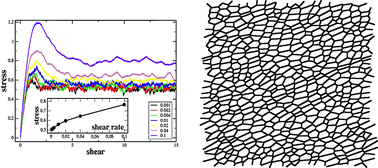Have you ever wondered what’s going on in a foam when it flows? In her latest Soft Matter paper, Isabelle Cantat at the Université Rennes, France, simulates the dissipation of bubbles in foam. Cantat used 2D numerical simulations involving 500 bubbles under simple shear, in a non-quasi static regime to study the dissipation of bubbles.
Cantat shows that small tension dynamical inhomogeneities induce foam structure modifications responsible for the largest part of the stress increase. The stress increase with increasing shear rate is mainly due to increasing bubble elongation that can be interpreted as an increase of the plastic threshold.
Interested to know more? Read Cantat’s Soft Matter paper here:











